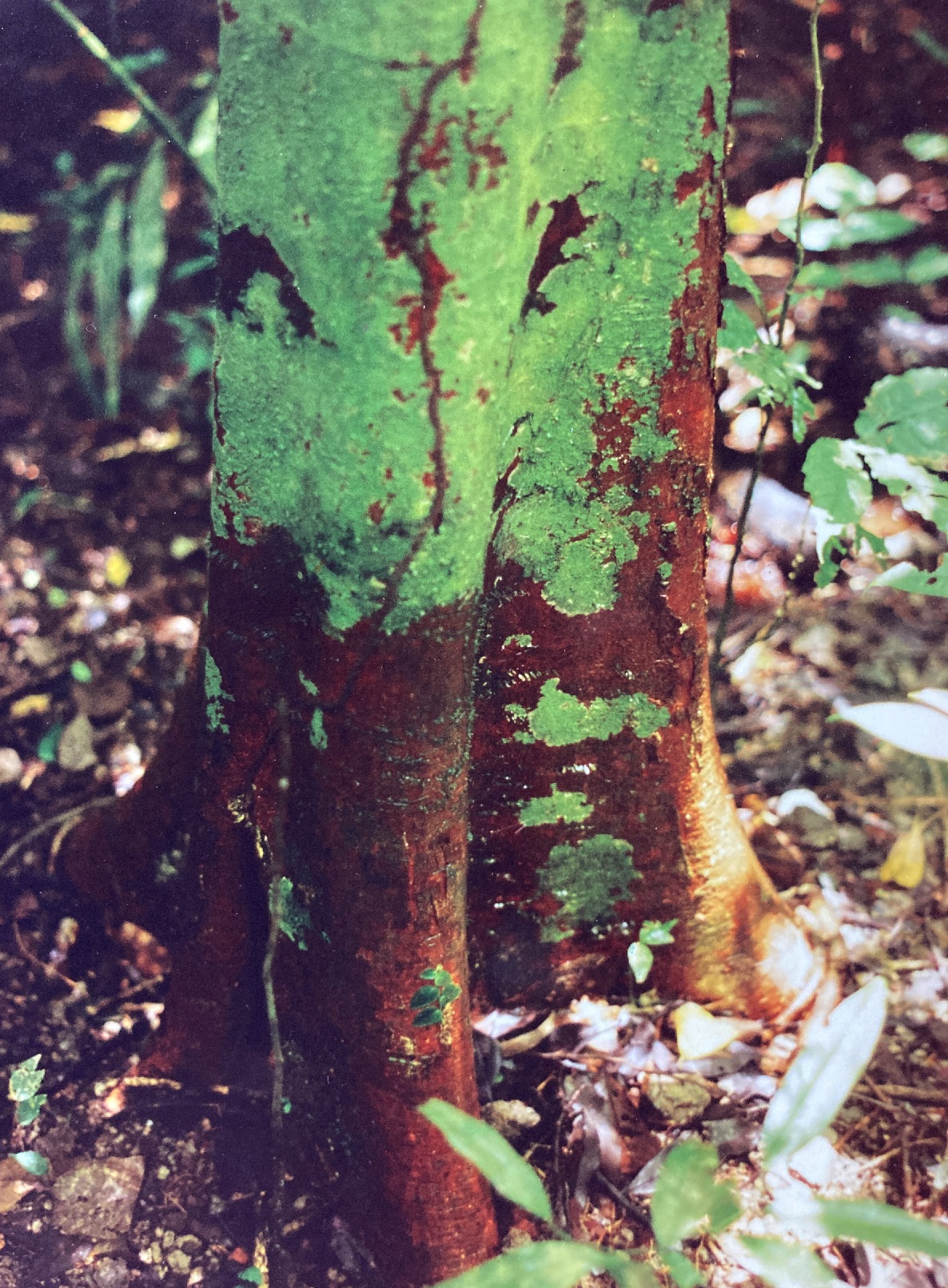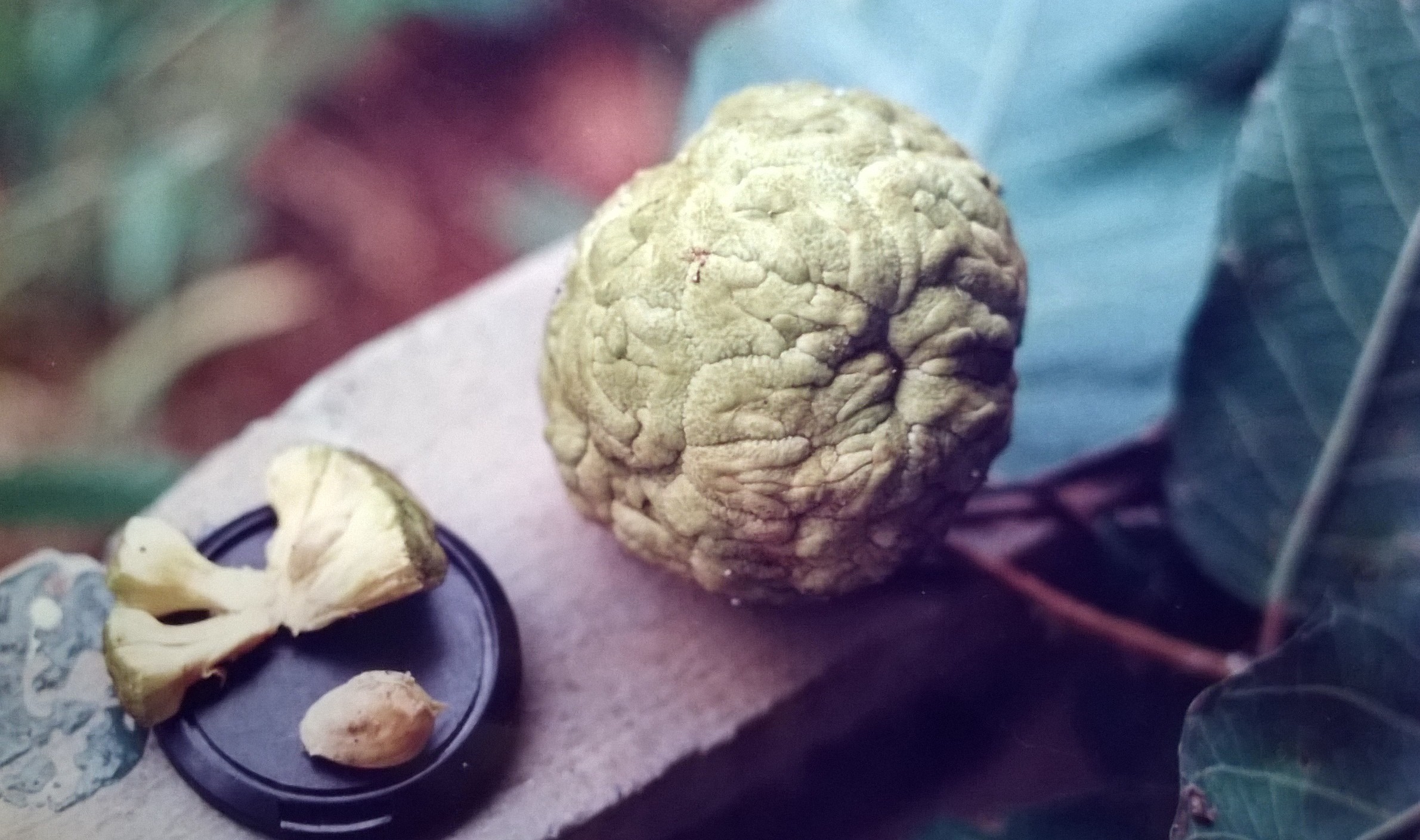Batocarpus costaricensis Standl. & L. Wms.
Moraceae OJOCHE MACHO
Occasional evergreen tree of subcanopy (15-20 m) proportions. The cylindrical and columnar, red-tinged trunks are capped by a crown of abundant, dark-green foliage, making this tree a handsome specimen worth finding. The Batocarpus fruit is especially intriguing for it bears an uncanny resemblance to a small, vertebrate brain – complete with the convolutions and creases expected of that organ’s cerebral cortex.
Description: The Batocarpus trunk (35 cm, but occasionally to 50 cm) is straight, mostly cylindrical, and slowly tapering. Low ridges, forming encircling rings, are visible at periodic intervals along its length. Relatively short branches emerge from the upper two thirds of the bole, forming a narrow, moderately dense, elongated crown. Buttresses – little more than the exposed surfaces of the first shallow roots – are rounded and low. Barely visible before entering the soil, they are none-the-less eye-catching due to the bright, orange-red color of the bark that covers them. Elsewhere, the thin, smooth bark is a darker shade of brownish-red. Abundant, white, milky latex sap is exuded by broken bark, twigs, and fruits.
Leaves are simple, alternate and variable in size and – to a lesser extent – shape. Averaging 16 cm long by 8 cm wide, they are widely elliptical and often falcate (bent or curving). Usually, the mid rib is skewed toward one side of the blade, further enhancing their unequal or asymmetrical quality. Blade surfaces are rough and sandpapery – especially underneath – and their margins mildly crenulate. Short petioles (3 mm) and abrupt, narrow, drip-dips (1.5 cm) mark the blade’s extremities. Leaf shedding and renewal occur in small increments at sporadic intervals throughout the year.
Flowers are unisexual with male and female blossoms located on separate trees (dioecious). Appearing only during alternate years, these rare blossoms are ephemeral and very difficult to observe. Male flowers are long, stringy, creme-colored catkins that grow from leaf axils and measure 25 cm in length by 1 cm in diameter. Existing for the sole purpose of producing pollen, each consists of little more than a long rope of closely-packed, short stamens. Female flowers are minute (1.5 cm), sessile, green globes. Each carries multiple, small, green pistils amid the creases on its surface. Flowering occurs in late May, and, since observations were begun in 1984, fertility has only been observed during alternate years (1985, 87, 89, 91, 93, 95).
Fruits grow rapidly as the globular bases of the female flowers expand, finally reaching diameters of about 10 cm. Of relatively great size and mass, their weight adds significantly to the stress supported by Batocarpus branches. Thanks to their elastic and flexible construction, these thin limbs merely bend under the added strain. Fruits finally mature as green-gold, lumpy, irregularly-spherical structures. Resembling small brains, the convolutions and creases covering outer surface of the fruit are strikingly reminiscent of the pattern exhibited by human cerebral cortex. Inside, the fruit is sectioned into thin, seed-containing wedges that are continuous with the creases on the surface. When ripe, the dense fruits soften (to the consistency and texture of crab meat!) and begin to disintegrate in the trees – occasionally falling to the earth with a great, heavy, smacking, self-destructive thud. About 30 rounded and slightly flattened, off-white seeds (1.5 cm) are embedded in the yellowish, mealy flesh of each fruit. Although it is not uncommon to find Batocarpus seedlings growing amid the shrub-layer vegetation of the forest, seed viability is apparently low and I have never witnessed germination. Harvests occur from August to October and are in sync with the fertility pattern previously described. The intensity of fruition, however, varies markedly among individual trees.
Similar Species: The large, asymmetrical leaves of this species distinguish it from most other Manuel Antonio trees save one: Theobroma angustifolium. With virtually identical (though notably pubescent) foliage, Theobroma is nonetheless a rare tree in Manuel Antonio and it lacks the reddish orange bark found on the lower Batocarpus bole and roots. Thick, white, latex sap and reddish or orange roots – Batocarpus hallmarks – are characteristics that typify many members of the Moraceae family.
Natural History: The simple and unadorned Batocarpus flowers are most likely pollinated by wind. Though never directly observed, fruits may be eaten by bats and/or other arboreal mammals since partially opened fruits are frequently visible in the canopy. Batocarpus trees are shade-tolerant plants adapted to the minimal light levels and high humidity prevalent within the tropical forest understory. Having evolved to thrive in this habitat, it is unlikely that this species could survive in the secondary forest.
Uses: Allen (1956) says that the wood is white, hard, and close-grained but not used locally.
Distribution: In Manuel Antonio, Batocarpus is common in low, poorly drained patches of primary forest. In Costa Rica, the species is restricted to the southwestern slope, and it ranges to Bolivia, Perú and Ecuador.
Photos: Tree Trunk Trunk2 Leaf Leaf2 Flowers (male) Flowers (female) Fruit Fruit2 Fruit3




